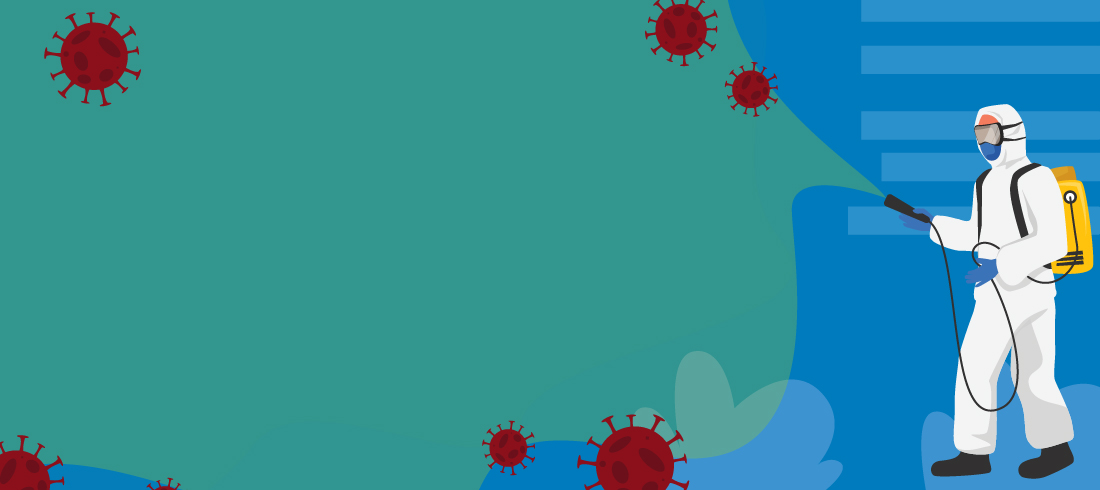The coronavirus pandemic is a serious public health and medical crisis that has caused widespread illness and death in almost every country. The pandemic has turned out to be not just a global health concern but has affected several other domains of daily life. The pandemic has caused an economic crisis due to which many forms of business activity are shut down as people isolate to avoid infection. That damages livelihoods, threatens the survival of businesses, and cuts public revenues. It is also an institutional and operational crisis for government and private organizations at all levels, as they struggle to provide services even while their own personnel may be seriously affected. Furthermore, it is a psychological crisis as individuals and families may be traumatized by fear, loss of loved ones and livelihoods and grief. Therefore, responding to COVID-19 requires recognizing and confronting all dimensions of this crisis together.
Every significant emergency event is a volcano of challenges in terms of identifying the issue and questions with no ready answers. Whatever level of resources are available, leaders need to establish effective structures and processes and assign committed people who can face and deal with these challenges to the greatest extent possible.
Nature of the coronavirus
The spread of the virus has been explosive in nature. China saw the earliest and greatest caseload, particularly in Wuhan/Hubei, but the United States has now become the most affected country in terms of the largest number of infections and deaths. Several countries in Europe have also experienced tremendous surges of cases.
The case counts in pandemics can be elusive and often misleading too. The number of cases is usually under-estimated. The most severe cases (those that get hospitalized or die) tend to be most accurately counted but not completely. Some people who seek care are not tested because of a shortage of test kits or physician work overload. Many individuals are never counted if they have mild cases, do not get medical treatment, and recover on their own. Some infected individuals are pre-symptomatic or a-symptomatic and are not counted. As a result, in the early stages of an epidemic, the death rate tends to be over-estimated as a percentage of total cases.
In the COVID-19 pandemic, distortions of the case count are also occurring because of differing definitions of cases and seemingly purposeful falsification in some countries to minimize national embarrassment. Cases of the corona virus are almost certainly being under counted everywhere, especially when the outbreak is initially getting established.
Strategies against COVID-19
Intervention against COVID-19 includes containment measures like surveillance, extensive testing, contact tracing and targeted isolation of infected or exposed individuals. Mitigation strategies include hand cleaning, curbs on work, school closures, group gatherings, social distancing, shelter-in-place and travel restrictions. Both methods seek to “flatten the curve” to slow the transmission, delay and reduce the peak, spread out the number of infections, avert hospital critical care overload and reduce deaths. These measures help in gaining time to prepare hospital system for surge in infections, develop and mass-distribute vaccine and develop prophylactic pharmaceuticals to treat the infected people. As a result, herd immunity will be developed.
Containment depends on widespread surveillance and testing to identify most cases early in an outbreak, sufficient epidemiological capacity to conduct intensive contact tracing, quarantine of persons found positive, isolation of contacts pending determination of infection status, robust border control. Containment may not stop an outbreak but it can moderate the speed and extent of spread and “flatten the curve” by reducing the peak of infections at one time. Success stories include Singapore, Hong Kong, Taiwan, and China outside of Wuhan – all locales that had experience with SARS.
Mitigation is necessary when an outbreak is well established and widespread so that containment based on intervening in individual cases is infeasible. Mitigation effort requires changes in personal behavior like careful hand-washing and minimization of social contacts. It also involves regulated social distancing in the form of travel restrictions, closing of schools and work places, cancellation of concerts and sporting events and limitations on group gatherings. However, mitigation may not work well if it is started too late, implemented too leniently, or flouted by too many people
Policies for Nepal in the current crisis
Clear and easy to understand public information about COVID-19 should be delivered by the national government. It should project empathy and concern for the hardships that the epidemic imposes and vigorously promote practices of personal hygiene and social distancing. These messages should be presented by respected and non-political voices and reinforced by provincial and local repetition. The national government should also ensure procurement and distribution of personal protective equipment for health care workers and, where possible, for first responders.
As many shelters and field hospitals should be developed as possible to keep people, who have tested positive or manifest COVID symptoms, separate from their families. Separate isolated facilities for treating seriously ill patients should also be arranged. Even before a vaccine for the virus becomes available, capacity building for mass distribution throughout the country and training of personnel to carry out inoculations should be carried out.
In addition to health care workers, Nepal’s active civil society organizations should be mobilized to serve as volunteers for providing credible public information about personal hygiene and self-isolation, monitor symptoms and provide meals, as well as minister to family members of infected or recovering people. Training for CSO members as paraprofessionals should also be imparted to aid in mass distribution of vaccine when it is ready.
Ethical questions and known unknowns
Questions that apply both within and between states are related to who gets tested and treated, who gets access to PPEs and different strategies on COVID-19 response. Transparency and accurate communication of information in a timely manner are crucial to maintain trust and confidence in governments.
One of the most crucial aspects of COVID-19 is an “exit” strategy – in other words, when to relax intensive social distancing and how to avert a “second wave” of infections once restrictions are gone. Questions that may arise include whether individuals who have recovered from COVID-19 have immunity or are susceptible to re-infection. Equally important is whether COVID-19 will generate a recurring, seasonal wave of infection or constantly evolve like influenza.
The way forward
The World Health Organization has provided strategic advice on lifting a lockdown. The primary criterion is that transmission of the virus must be controlled. Health systems should be able to test, detect cases, treat and contact-trace all cases. Outbreak risks should be minimized in special settings like nursing homes and medical facilities. Preventive measures should be in place in schools and workplaces. It is equally important that the virus importation risks be managed and communities are fully empowered to adjust to the “new normal”. For Nepal, prevention measures include effective social distancing and access to clean water and sanitation.
The United Nations has devised a COVID-19 global humanitarian response plan. It includes containing the spread of the COVID-19 pandemic and decreasing morbidity and mortality. It also involves decreasing the deterioration of human assets and rights, social cohesion and livelihoods, protecting, assisting and advocating for refugees, internally displaced people, migrants and hosting communities particularly vulnerable to the pandemic. The WHO has appealed for US$ 675 million to fund the COVID-19 response. Similarly, the United Nations has requested US$ two billion for global humanitarian response plan to fight the pandemic.
Mitigating the impacts of future epidemics
COVID-19 has shown the importance of investment in public health infrastructure at all levels of government. Initiatives at the national level may include providing expertise, developing policies and reporting systems, aggregating and analyzing surveillance information, conducting training, providing public information and building international liaison. At the provincial level, activities such as operating surveillance systems, conducting training of local health personnel, distributing public information and coordinating with national agencies should be conducted. The local level should involve itself in recruiting and training paraprofessional health workers, collaborating with civil society organizations and providing support to ill residents.
The government of Nepal should ensure improving cooperative relationships among agencies at and across levels of government. It should also create a capable central coordinating entity, including capability to create collaboration between civilian agencies and the Nepali Army and insist on transparency and open communication of information. Nepal is addressing an extremely complex crisis under a new constitution and through three tiers of government and institutions that are still establishing their authorities, capabilities, and relationships with each other. Therefore, it needs to mobilize these institutions in an effective manner during the corona virus crisis and collaborate with each other under extremely difficult circumstances.
*** *** *** *** *** *** *** *** *** *** *** *** *** *** *** *** *** *** *** *** *** *** *** *** *** *** ***
The live session with Dr. Howitt and Dr. Bollettino was hosted on DCNepal Facebook page. The session was anchored by Senior Security Specialist from Nepal – Mr. Chiran Jung Thapa on April 17, 2020. The video link has been shared below with the permission of Mr. Thapa.
कोरोना भाइरस र यसको विपद् बाट कसरी बच्ने ? के भन्छन् हार्डवर्ड विश्वविद्यालयका विज्ञहरु ?
कोरोना भाइरस र यसको विपद् बाट कसरी बच्ने ? के भन्छन् हार्डवर्ड विश्वविद्यालयका विज्ञहरु ?संसारभर कोरोना महामारी चलिरहेका बेला अमेरिकाको विश्व प्रसिद्ध हार्डवर्ड विश्वविद्यालयका विपद् व्यबस्थापन विज्ञहरु Dr. Arnold M. Howitt, Ph.D. तथा Dr. Vincenzo Bollettino, Ph.D. संग नेपालका सुरक्षाविद् चिरनजंग थापाले गरेको कुराकानी डिसी नेपालको फेसबुक पेजबाट प्रत्यक्ष प्रसारण ।
DCnepal ಅವರಿಂದ ಈ ದಿನದಂದು ಪೋಸ್ಟ್ ಮಾಡಲಾಗಿದೆ ಶುಕ್ರವಾರ, ಏಪ್ರಿಲ್ 17, 2020



